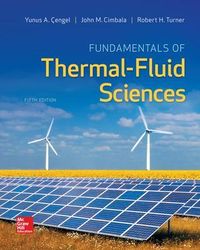
Fundamentals of Thermal-Fluid Sciences Upplaga 5
This book is intended for use as a textbook in a first course in thermal-fluid sciences for undergraduate engineering students in their junior or senior year, and as a reference book for practicing engineers. Students are assumed to have an adequate background in calculus, physics, and engineering mechanics.
The objective of this text are to cover the basic principles of thermodynamics, fluid mechanics, and heat transfer. Diverse real-world engineering examples are presented to give students a feel for how thermal-fluid sciences are applied in engineering practice. By emphasizing the physics and physical arguments, students are able to develop intuitive understanding of thermal-fluid sciences.
The text contains sufficient material to give instructors flexibility and to accommodate their preferences on the right blend of thermodynamics, fluid mechanics, and heat transfer for their students. By careful selection of topics, an instructor can spend one-third, one-half, or two-thirds of the course on thermodynamics and the rest on selected topics of fluid mechanics and heat transfer.
The following supplements are now available: Student Resource DVD (Engineering Equation Solver---EES), Text Website---instructor and student resources, COSMOS (Complete Online Solutions Manual Organization System).
Also available with the fifth edition is Connect. Connect is the only integrated learning system that empowers students by continuously adapting to deliver precisely what they need, when they need it, how they need it, so that your class time is more engaging and effective.
Upplaga: 5e upplagan
Utgiven: 2016
ISBN: 9780078027680
Förlag: McGraw-Hill Professional
Format: Inbunden
Språk: Engelska
Sidor: 1088 st
This book is intended for use as a textbook in a first course in thermal-fluid sciences for undergraduate engineering students in their junior or senior year, and as a reference book for practicing engineers. Students are assumed to have an adequate background in calculus, physics, and engineering mechanics.
The objective of this text are to cover the basic principles of thermodynamics, fluid mechanics, and heat transfer. Diverse real-world engineering examples are presented to give students a feel for how thermal-fluid sciences are applied in engineering practice. By emphasizing the physics and physical arguments, students are able to develop intuitive understanding of thermal-fluid sciences.
The text contains sufficient material to give instructors flexibility and to accommodate their preferences on the right blend of thermodynamics, fluid mechanics, and heat transfer for their students. By careful selection of topics, an instructor can spend one-third, one-half, or two-thirds of the course on thermodynamics and the rest on selected topics of fluid mechanics and heat transfer.
The following supplements are now available: Student Resource DVD (Engineering Equation Solver---EES), Text Website---instructor and student resources, COSMOS (Complete Online Solutions Manual Organization System).
Also available with the fifth edition is Connect. Connect is the only integrated learning system that empowers students by continuously adapting to deliver precisely what they need, when they need it, how they need it, so that your class time is more engaging and effective.
Begagnad bok (0 st)
Varje vecka tillkommer tusentals nya säljare. Bevaka boken så får du meddelande när den finns tillgänglig igen.



